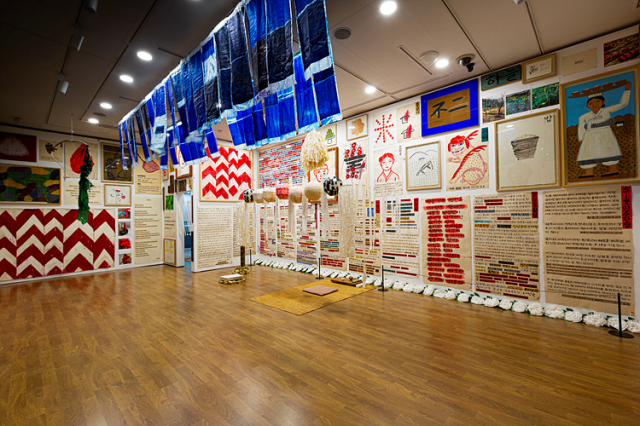
Fluttering-All is alive!
Lee Jinkyung
A quiet surface densely filled with handwritten text.
Over it, faint images of plants, moons, vanished landscapes, and forgotten names drift in and out of view.
Working from her studio in Hongcheon, Gangwon Province, Korean artist Lee Jin Kyung weaves together drawing and writing to recover stories of time gone by and people long overlooked.
At a distance, her works may resemble drawings. But as viewers draw near, they discover that each line, each contour, is made of handwritten words. These are not just marks—they are lives, names, pain, and memory. Lee writes them not with loud gestures, but with quiet insistence and unwavering care.
For this Biennale, the focus shifts to the Jeollanam-do region.
Through handwritten texts and subtle images, she brings forth the region’s layered history and emotional landscape: the abundance of southern cuisine, local folk songs like Minyo and Honam-ga, the Amtaedo tenant farmers’ uprising, and the poetry of Mokpo-born writer Kim Jiha.
In particular, her act of listing names—those who spoke out even under oppression—is not merely enumeration. It becomes a confrontation with history, a space for remembrance.
As viewers read each name slowly, reflection follows. Lee’s work reminds us why remembering remains a vital, ethical gesture.
This is not work to simply be seen.
It is meant to be read, felt, and listened to—with the heart.
Each stroke of her pen holds the weight of time. And within that time, we understand that “civilization” is not built by grand narratives alone, but by the fragile and resilient stories of individual lives.
Echoing the theme of this Biennale, Neighbors of Civilization, Lee Jin Kyung’s work quietly states:
what we truly share is not images,
but memory.
And as you stand before this work,
you too may become a person who calls a forgotten name,
and feels—if only for a moment—their time and tenderness stir within you.
Over it, faint images of plants, moons, vanished landscapes, and forgotten names drift in and out of view.
Working from her studio in Hongcheon, Gangwon Province, Korean artist Lee Jin Kyung weaves together drawing and writing to recover stories of time gone by and people long overlooked.
At a distance, her works may resemble drawings. But as viewers draw near, they discover that each line, each contour, is made of handwritten words. These are not just marks—they are lives, names, pain, and memory. Lee writes them not with loud gestures, but with quiet insistence and unwavering care.
For this Biennale, the focus shifts to the Jeollanam-do region.
Through handwritten texts and subtle images, she brings forth the region’s layered history and emotional landscape: the abundance of southern cuisine, local folk songs like Minyo and Honam-ga, the Amtaedo tenant farmers’ uprising, and the poetry of Mokpo-born writer Kim Jiha.
In particular, her act of listing names—those who spoke out even under oppression—is not merely enumeration. It becomes a confrontation with history, a space for remembrance.
As viewers read each name slowly, reflection follows. Lee’s work reminds us why remembering remains a vital, ethical gesture.
This is not work to simply be seen.
It is meant to be read, felt, and listened to—with the heart.
Each stroke of her pen holds the weight of time. And within that time, we understand that “civilization” is not built by grand narratives alone, but by the fragile and resilient stories of individual lives.
Echoing the theme of this Biennale, Neighbors of Civilization, Lee Jin Kyung’s work quietly states:
what we truly share is not images,
but memory.
And as you stand before this work,
you too may become a person who calls a forgotten name,
and feels—if only for a moment—their time and tenderness stir within you.
